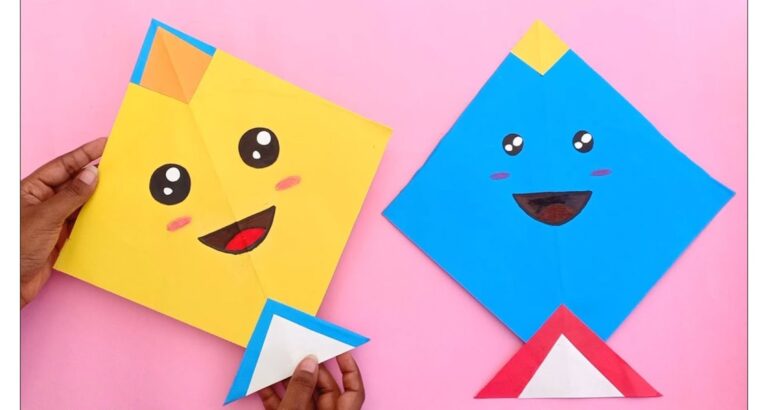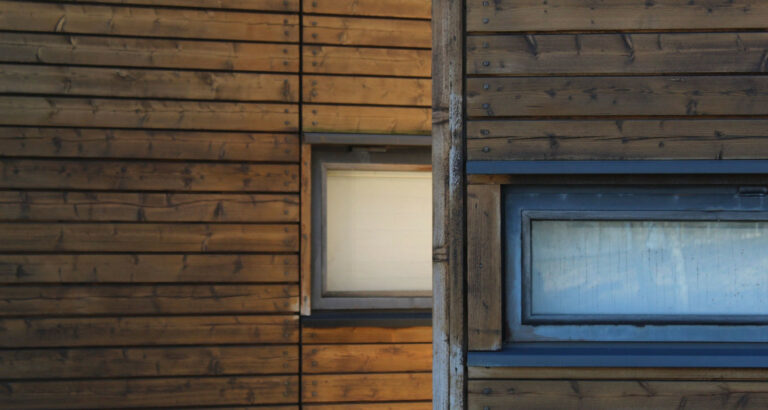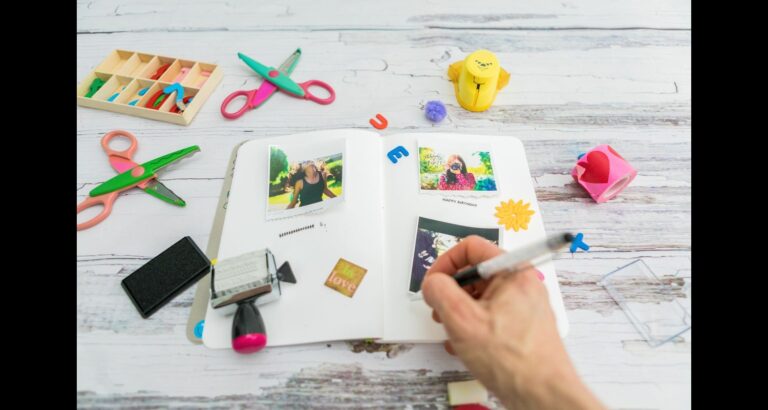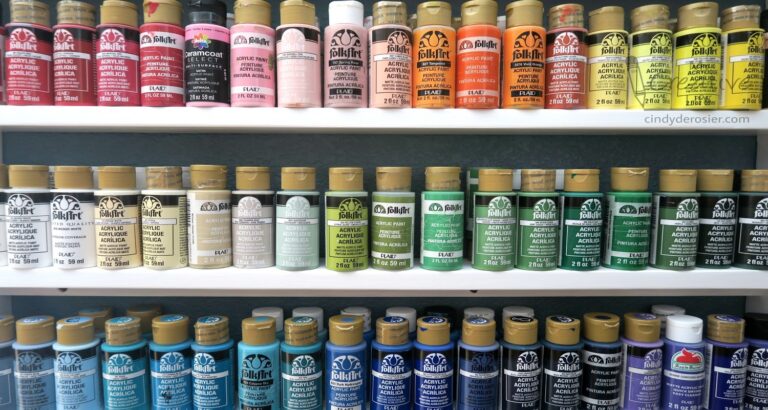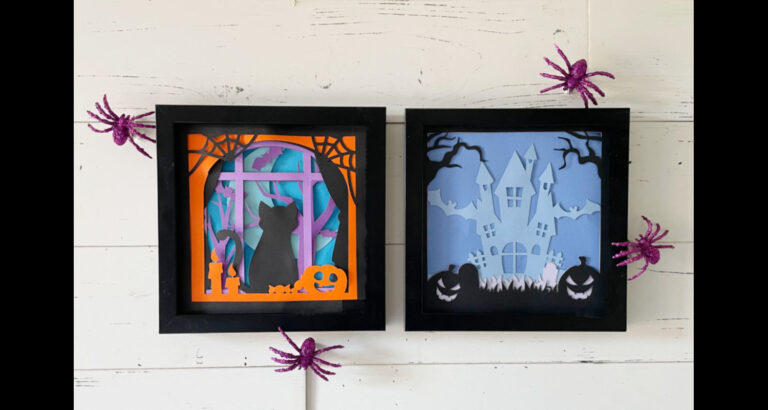Craft fairs are bustling hubs of creativity, but they can also be overwhelming. As an artist, standing out is crucial but not always easy. This article is your lifeline. It demystifies the art of display, transforming your booth into a magnet for art lovers. Discover secrets to showcasing your art that captivate and sell. Prepare to make your mark at your next craft fair with “How to display art at a craft fair”!
Display art at a craft fair by choosing eye-catching setups, using effective lighting, and incorporating unique display props. Create a visually appealing and organized space that highlights your art’s best features, ensuring it’s easily accessible and well-lit.
Essentials of Art Display at Craft Fairs
Craft fairs are more than just a place to sell art; they’re a canvas to showcase your creativity and connect with art lovers. Here’s display art at a craft fair.
Selecting the Right Display Equipment
- Easels and Tables: Your display starts with the right foundation. Choose easels that match the size and weight of your canvases. For table displays, height matters. Aim for counter height for easy browsing, as bending over standard tables can be uncomfortable.
Importance of Lighting
- Spotlights and Mood Lighting: Art needs to be seen in the best light. Use clamp-on lights or battery-operated LEDs to highlight your art. Think mood too; soft lighting can create a warm, inviting space.
Creating a Visual Impact
- Large-Scale Art: Big pieces draw attention from afar. Use them as your booth’s focal point. If most of your work is small, consider a large-scale poster of your most impactful art.
Cohesion and Theme
- Unified Look: Your display should tell a story. Use a color scheme that complements your art, creating a cohesive experience for the viewer. Props and backdrops should enhance, not overpower, your artwork.
Practical Arrangements
- Strategic Placement: The placement of your art is key. Group similar works together for drama and impact. Keep your display uncluttered to let each piece shine.
Your “display art at a craft fair” at a craft fair is more than just showing your work; it’s about creating an experience that draws people in and makes them remember you.
Would you like to continue with the next section?
Crafting a Visually Appealing Booth
Transforming your booth into an art oasis not only showcases your work but also tells a story about your artistic journey. Here’s how to craft a booth that’s both inviting and memorable.
Using a Variety of Frames
- Mix and Match: Different frames add depth and interest. Experiment with sizes, shapes, and colors to find a cohesive, appealing look. This approach keeps eyes moving and engaged with your display.
Incorporating a Color Scheme
- Thematic Colors: Select a color scheme that enhances your artwork. Consistency in color throughout your booth creates a visually harmonious environment, making your art the star of the show.
Enhancing with Lighting
- The Power of Light: Good lighting is crucial. It not only highlights your art but also sets the mood. Whether it’s bright lights for clarity or soft lighting for ambiance, make sure your artwork is always in the best light.
Adding Height with Shelving
- Elevate Your Art: Utilize shelving to add vertical dimensions to your display. This not only saves space but also brings the art closer to eye level, making it more engaging for viewers.
Utilizing Props for Interest
- Props That Complement: Use props that resonate with your art style. Nature-inspired prints? Add small plants or stones. This adds layers to your story, making the booth more than just a place to browse art.
Promoting with Signage
- Brand Visibility: Clear signage with your brand and artwork information is key. Eye-catching signs, banners, or even QR codes enhance brand recall and connect your offline presence with online platforms.
Crafting a visually appealing booth is about creating a space that displays your art and invites visitors into your artistic world.
Maximizing Space and Attractiveness
In a craft fair, space is precious and first impressions are key. Here’s how to maximize your booth’s space and appeal, making every square inch count.
Strategic Use of Space
- Smart Layouts: Think about the flow of traffic through your booth. Arrange your displays to guide visitors naturally, showcasing your art without overcrowding. This approach helps in creating an inviting space that encourages browsing and engagement.
Utilizing Multi-Level Displays
- Levels and Layers: Create depth and interest by using various levels for your display. Elevated platforms, hanging pieces, or staggered shelving can give a dynamic look to your space. This method not only showcases more art but also makes it accessible and engaging.
Creative Prop Integration
- Props as Display Tools: Use creative props like baskets, crates, or artistic frames to add a unique touch. These elements can serve dual purposes: enhancing your display’s aesthetic and offering additional space to showcase your art.
Clutter-Free and Organized
- Simplicity is Key: While it’s tempting to show everything you have, a cluttered space can be overwhelming. Opt for a clean, organized display, allowing each piece of art to stand out. This setup makes it easier for visitors to focus and appreciate your work.
Attractiveness through Cohesion
- Consistent Theme: A cohesive theme or style across your booth creates a unified look. This consistency makes your booth more memorable and helps in building a strong brand identity.
Maximizing space and attractiveness in your craft fair booth isn’t just about displaying art; it’s about creating an immersive experience that resonates with visitors.
Practical Tips for Display Setup
Setting up your booth at a craft fair isn’t just about aesthetics; it’s also about practicality and effectiveness. Here are some tips to ensure your display is both beautiful and functional.
Secure and Safe Displays
- Stability is Crucial: Ensure all displays, especially those holding your art, are stable and secure. Use appropriate fasteners, like frame hanging wire or tape, to prevent any accidents during busy fair periods.
Effective Use of Banners and Signs
- Visibility with Signage: Hang banners and signs with your name, logo, and contact information. This not only aids in brand recognition but also makes it easy for interested buyers to contact you.
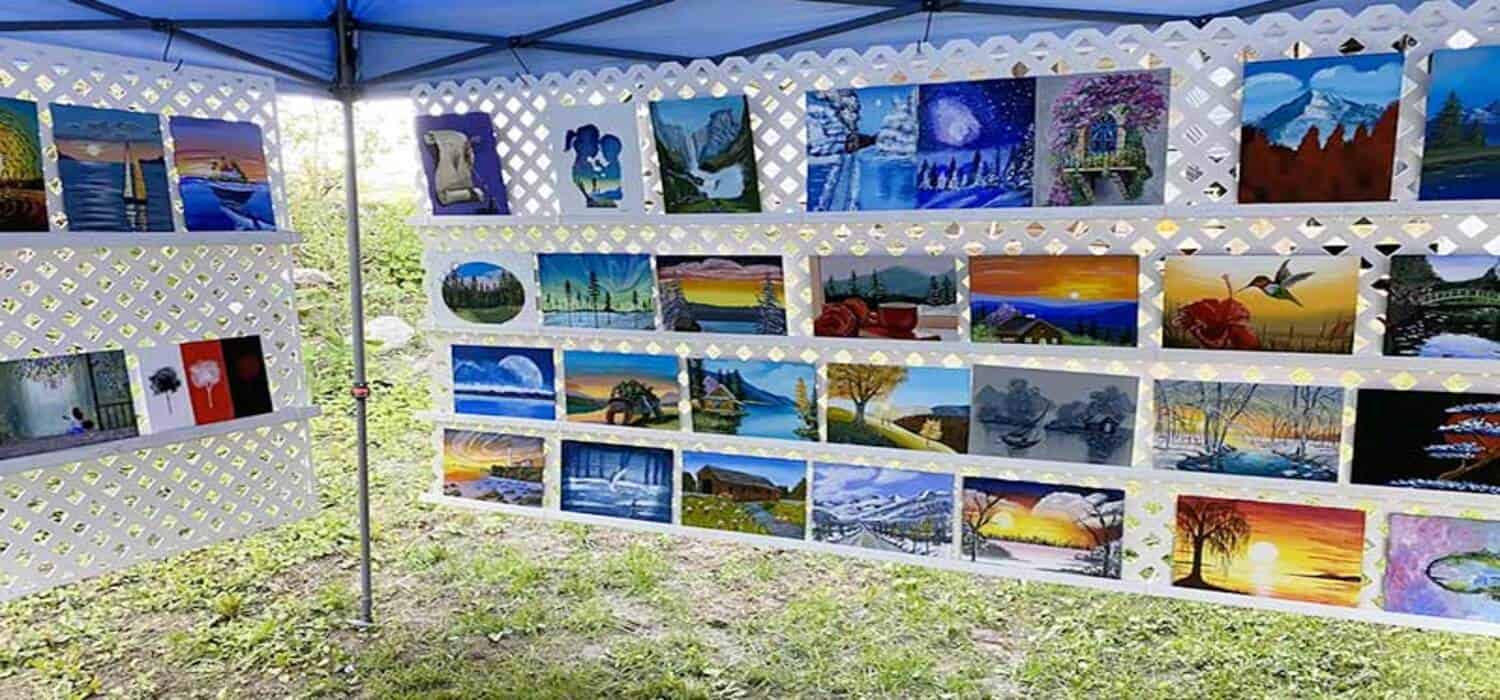 Price tags should be clear and informative, providing all necessary details about each piece.
Price tags should be clear and informative, providing all necessary details about each piece.
Networking and Social Media
- Leverage Connections: Network with other vendors to potentially expand your reach. Share pictures of your display on social media to attract more visitors to your booth. This dual approach of in-person and online networking can significantly increase your visibility.
Sun Protection for Artwork
- Guard Against Sun Damage: If your booth is outdoors, take steps to protect your artwork from sun damage. Use canopies, umbrellas, or other coverings to shield your art from direct sunlight.
Optimal Art Placement
- Eye-Level Display: Place your key pieces at eye level. This makes it easier for customers to view and appreciate your work without strain.
Lighting Considerations
- Illumination Matters: Use lighting strategically to showcase your art in its true colors. Avoid over-illumination, but ensure that each piece is well-lit.
Secure Payment Options
- Easy Transactions: Offer secure payment options. Be prepared with a cash box, card readers, or digital platforms like Square or PayPal. Consider taking deposits to reserve artwork for interested customers【11†source】.
Incorporating these practical tips into your display setup will not only make your booth more attractive but also more efficient and customer-friendly.
Pricing and Selling Your Art
Effectively pricing and selling your art at a craft fair is as much an art as the creations you display. Here’s how to navigate this crucial aspect.
Understanding Art Value
- Factor in Costs: When setting prices, consider material costs, time spent, and any additional expenses like framing. This ensures you’re fairly compensated for your work.
Competitive Pricing
- Market Research: Understand the going rates for similar artwork. This helps in setting competitive yet reasonable prices that attract buyers without underselling your talent.
Clear and Professional Pricing
- Labeling is Key: Use clear, professional-looking labels for each piece. Include the title, medium, and price. Easy-to-read and accessible pricing information helps customers make informed decisions.
Payment Flexibility
- Diverse Payment Options: In today’s digital age, offering multiple payment options, including card payments, can be a game-changer. Tools like Square make transactions seamless and encourage more sales.
Special Offers and Discounts
- Incentivize Purchases: Consider offering discounts for multiple purchases or special offers. This can create a sense of urgency and encourage bulk buying, boosting your overall sales.
Display Panel Usage
- Effective Showcasing: Utilize display panels to arrange your art in an appealing and organized manner. This not only showcases your art effectively but also aids in visual pricing and easy selection by customers.
Pricing and selling your art at a craft fair is about striking the right balance between valuing your work and appealing to the fair’s audience. A thoughtful approach to pricing and sales strategies can significantly impact your success.
Unique Display Ideas
Creating a unique and memorable booth at a craft fair can set you apart from the crowd. Here are some inventive display ideas to make your booth stand out.
Using Curtains and Doors
- Creative Separation: Curtains can define and personalize your space, giving it a distinctive look. Doors can be used as self-standing screens for displaying art or as a backdrop, adding a rustic or vintage charm.
Alternative Furniture Pieces
- Dressers and Drawers: Swap out the typical table for a dresser to add character. Use its drawers for displaying smaller items or storing extra stock. Even standalone drawers can be stacked for a unique shelving solution.
Unconventional Display Surfaces
- Drying Racks and Ironing Boards: Repurpose items like laundry drying racks or ironing boards for a quirky display. They can hold a variety of items, adding a novel twist to your setup.
Creative Use of Frames
- Frames as Signage: Picture frames can be used for signage or filled with materials like corkboard or burlap for a functional yet aesthetic display option.
Elevating with Fruit Baskets
- Vertical Display Options: Hanging or tiered fruit baskets provide height and layers, making them perfect for displaying smaller items in an eye-catching way.
Grid Walls for Art
- Vertical Space Maximization: Grid walls are excellent for hanging art, providing ample space and a modern look. They’re especially useful for art-heavy displays.
Adding Ambiance with Lighting
- Lamps and Mini Lights: Lamps not only add light but can also serve as part of the display. Mini lights can create a festive or intimate atmosphere, depending on your theme.
By incorporating these unique display ideas, you can create a booth that not only showcases your art effectively but also captures the imagination of craft fair visitors.
Engaging Potential Buyers
Attracting and engaging potential buyers at a craft fair is crucial for successful sales. Here’s how to make your booth not just a “Hdisplay art at a craft fair” but an interactive experience.
Creating an Attention-Grabbing Setup
- Showcase Eye-Catching Pieces: Place your most striking paintings or prints on the outer walls of your booth. This draws in customers and sets you apart from other booths.
Interactive Elements
- Host a Giveaway or Game: Adding a fun element like a giveaway or a game can create excitement. Offer a small art piece or a discount as a prize. This approach not only attracts people but also encourages them to engage with your art.
Demonstrating Artistic Process
- Live Demonstrations: If feasible, demonstrate your artistic process live at your booth. This not only showcases your skill but also gives customers a deeper appreciation for the art they’re buying.
Offering Variety
- Diverse Options: Cater to different preferences and budgets by offering a range of prints in various sizes and styles. Having both affordable and premium options can widen your customer base.
Building Connections
- Engage in Conversation: Talk to your visitors. Share stories about your art, ask them about their preferences, and answer their questions. Personal interactions can significantly boost interest and sales.
Using Social Media
- Online Engagement: Encourage visitors to follow you on social media. Post about the event and your booth in real-time to attract more foot traffic. This also helps in building a long-term audience for your art.
Engaging potential buyers is about creating an experience that’s memorable and personal. It’s not just about the art they see, but also the interactions they have and the stories they hear.
Conclusion
Craft fairs are a fantastic opportunity for artists to showcase their work and connect with art lovers. By creating an engaging, visually appealing booth and employing strategic display techniques, you can significantly enhance the visibility and appeal of your art. Remember, it’s not just about making sales but also about building relationships with potential buyers and creating a memorable experience for them.
Utilize lighting effectively, maximize your space, and employ unique display ideas to make your booth stand out. Engage with your audience, use interactive elements, and showcase a variety of art to cater to different tastes and budgets. Most importantly, enjoy the process and use this opportunity to express your artistic vision and connect with the art community.
As you prepare for your next craft fair, remember these tips to create a display that not only showcases your art in the best light but also turns visitors into admirers and customers. Good luck, and may your art find its perfect audience with our “Hdisplay art at a craft fair”!
FAQs
What is the most effective way to display art at a craft fair?
The most effective way involves using eye-level displays, good lighting, and a cohesive theme. Ensure your artwork is easily accessible and highlighted with proper lighting to attract attention.
How can I make my art stand out at a craft fair?
Utilize unique display props, create an engaging booth layout, and use a variety of frames and color schemes. Also, consider demonstrating your artistic process or hosting interactive elements to engage visitors.
What are some creative display ideas for a craft fair booth?
Consider using unconventional props like dressers or drying racks, incorporating layers with shelves, and adding personal touches like custom signage or themed decorations to enhance your booth's appeal.
How should I price my art for a craft fair?
Price your art by considering the cost of materials, time spent, and the overall market value. Be transparent with pricing, using clear labels and signs to inform potential buyers.
What are some tips for engaging potential buyers at a craft fair?
Engage buyers by sharing stories about your art, offering a variety of styles and sizes, and using social media to promote your booth. Personal interactions and understanding customer preferences can greatly enhance sales potential.

I am Sammy and I blog at Live it. Love it. Make it. It is creative lifestyle blog run by best friends H and Sammy. Head over and follow our crafty adventures!

